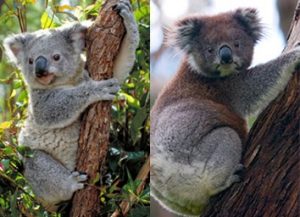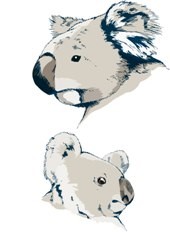About Koalas
THE KOALA
The koala, Phascolarctos cinereus, is an arboreal species listed as vulnerable under the Environment Protection and Biodiversity Conservation Act 1999 (EPBC Act) in Queensland, New South Wales and the Australian Capital Territory. The koala’s is found from tropical north Queensland, to temperate regions in New South Wales, the Australian Capital Territory, Victoria and a small part of south-east South Australia. Experiencing decline, Koalas are under threat of local extinctions. This is due to reduced habitat, vegetation fragmentation, climate change effects, disease, severe bushfires, attacks from other animals vehicle-strikes.
DERIVATION
Koala meaning ‘no water’ is thought to come from the Dharug peoples of Parramatta and Blue Mountains. However, koalas are also known as ‘dumbirrbi’ in the Jagera language, ‘marrambi’ in the Yugarabul language, ‘borobi’ in the Ugambeh and ‘dumbribbi’ in the Turrbul language.
APPEARANCE OF THE KOALA
Department of Environment and Science (2021)
 Appearances of koalas varies across its range. Victorian koalas are larger and have thicker fur than their northern counterparts. Queensland koalas are smaller, females are typically 5 – 6 kg and males 6 – 8 kg, and lighter in colour than those found in New South Wales, South Australia and Victoria where females average 8.5 kg and males up to 12 kg.
Appearances of koalas varies across its range. Victorian koalas are larger and have thicker fur than their northern counterparts. Queensland koalas are smaller, females are typically 5 – 6 kg and males 6 – 8 kg, and lighter in colour than those found in New South Wales, South Australia and Victoria where females average 8.5 kg and males up to 12 kg.
Left: Northern Koala | Right: Southern Koala
 Male koalas are significantly larger than female koalas and tend to have a broad face and larger nose. Males have a distinctive stain on their chest from a large scent gland whereas females have a clean white chest. Females have a backward facing pouch that protects their young from injury when moving amongst trees.
Male koalas are significantly larger than female koalas and tend to have a broad face and larger nose. Males have a distinctive stain on their chest from a large scent gland whereas females have a clean white chest. Females have a backward facing pouch that protects their young from injury when moving amongst trees.
Top: Male Koala | Bottom: Female Koala
HISTORICAL FACTS
In decline ever since Europeans settled in Australia, koalas were extensively hunted during the 1800s and early 1900s for their pelts. Several millions of pelts were shipped overseas, before koalas became protected in the early 1900s. By then koala numbers had dropped by more than 50 % of that which existed prior to European settlement.
BREEDING AND ADAPTATION
- In Victoria, the breeding season occurs from September to January (Spring – Summer).
- Males are polygynous and mate with several females. Vigorous confrontations and rejections from a female can occur.
- Males advertise themselves using vocalisations called bellows, usually heard extensively at night between 8 pm – 2 am in Victoria.
- Females are induced ovulators (needing external stimuli to ovulate during or prior to mating, rather than regular cyclical ovulation).
KOALA REPRODUCTION AND DEVELOPMENT
- Reproduction: females have one offspring per breeding season and rarely have twins.
- Gestation: lasts approximately 35 days, a joey is born under-developed (hairless, blind, and earless).
- Birth: a jellybean sized joey about 6 mm long finds its way into the mother’s downward-facing pouch.
- Pouch development: the highly susceptible and vulnerable young remain in the pouch for the first 6 – 9 months attached to one of the two available teats and feeds on milk until completely developed and then moves to the mother’s back.
- Outside of the pouch: the joey then begins to explore and to consume small quantities of the mother’s “pap” (from the mother’s caecum) in order to inoculate its gut with the microbes necessary to digest eucalypt leaves.
- Weaning is complete at about 12 months of age. After the first year of life, a juvenile tends to move away from the mother but stays close by/overlapping with the mother’s home range.
- After 2 – 3 years: once a young koala is ready to breed, they tend to move beyond their original home range.
- Adults: females reach sexual maturity at 2 to 3 years of age and males at a later stage around 3 – 4 years of age. In the wild, koalas can live up to 12 years of age.
DIET AND GUT FUNCTION
- Folivores, or leaf eaters, use hindgut fermentation to digest eucalyptus leaves which provide low nutrition and energy, promoting a low activity lifestyle.
- Eucalyptus leaves are low in available protein and carbohydrate and have polyphenolic compounds which make them difficult to digest.
- Over time, koalas have developed a palate towards the front of the skull, larger molars and premolars, and a greater gap between the molar and incisor teeth. The evolution of this type of dentition has allowed koalas to efficiently masticate leaves which aids the absorption of nutrients. However, they still require breaks between feeding so that toxins can be processed, isolated by the liver and then excreted as urine and faeces. Any remaining residue is finally broken down by bacteria in an elongated caecum.
- It is essential for the mother to introduce ‘pap’, a maternal faecal paste made in the caecum, to the joey emerging from the pouch in preparation for a lifelong eucalyptus diet.
THE VICTORIAN KOALA
In South Australia and Victoria, koala populations are stable, mainly due to overabundance in some landscapes, but in most Victorian forests they occur in low-density populations of 1 per hectare. The actual status of Victorian koala populations is unclear because of the lack of formal long term monitoring and field studies which are important for conservation purposes. In Victoria, koalas are relatively widespread, occurring in intact forested landscapes, as well as, a range of landscapes that have been modified for agriculture, livestock production, timber harvest and urban development. In some areas, koalas are abundant and clearly visible, such as in the Otway Ranges, Strathbogie Ranges, French Island and Raymond Island. Vegetation in these areas exhibit pressure from over browsing and extensive thinning of preferred tree species which can lead to emaciated koalas.
Home range can vary from location to location and depends greatly on the suitability of vegetation and the population density. In Victoria, the home range is typically between 1 – 50 hectares. However, in Queensland the home range in certain areas like Blair Athol in Central Queensland can be up to 136 ha. This may be due to the gaps in vegetation and the need for koalas to move further distances to reach better food trees.
References
Ashman, KR, Watchorn, DJ & Whisson, DA 2019, ‘Prioritising research efforts for effective species conservation: a review of 145 years of koala research’, Mammal Review, vol. 49, pp. 189-200.
de Oliveira, SM, Murray, PJ, de Villiers, DL & Baxter, GS 2014, ‘Ecology and movement of urban koalas adjacent to linear infrastructure in coastal south-east Queensland’, Australian Mammalogy, vol. 36, pp. 45-54.
Department of Environment and Science 2021, Koala facts, Queensland Government, retrieved 16 April 2021, <https://environment.des.qld.gov.au/wildlife/animals/living-with/koalas/facts>.
Department of the Environment 2014, EPBC Act referral guidelines for the vulnerable koala: combined populations of Queensland, New South Wales and the Australian Capital Territory, Commonwealth of Australia, retrieved 19 February 2020, <https://www.environment.gov.au/system/files/resources/dc2ae592-ff25-4e2c-ada3-843e4dea1dae/files/koala-referral-guidelines.pdf>.
Goldingay, RL & Dobner, B 2014, ‘Home range areas of koalas in an urban area of north-east New South Wales’, Australian Mammalogy, vol. 36, no. 1, pp. 74-80.
McAlpine, C, Lunney, D, Melzer, A, Menkhorst, P, Phillips, S, Phalen, D, Ellis, W, Foley, W, Baxter, G, de Villiers, D, Kavanagh, R, Adams-Hosking, C, Todd, C, Whisson, D, Molsher, R, Walter, M, Lawler, I & Close, R 2015, ‘Conserving koalas: a review of the contrasting regional trends, outlooks and policy challenges’, Biological Conservation, vol. 192, pp. 226-36.
Melzer, A, Carrick, F, Menkhorst, P, Lunney, D & St. John, B 2000, ‘Overview, critical assessment, and conservation implications of koala distribution and abundance’, Conservation Biology, vol. 14, no. 3, pp. 619-28.
Menkhorst, P 2004, ‘Victoria’s koala management strategy’. Victorian Government. Department of Sustainability and Environment, East Melbourne, Vic.
Menkhorst, P 2008, ‘Hunted, marooned, re-introduced, contracepted: a history of koala management in Victoria’, Australian Zoologist, vol. 34, no. SPEC. ISS., pp. 73-92.
Rhodes, JR, Ng, CF, de Villiers, DL, Preece, HJ, McAlpine, CA & Possingham, HP 2011, ‘Using integrated population modelling to quantify the implications of multiple threatening processes for a rapidly declining population’, Biological Conservation, vol. 144, no. 3, pp. 1081-8.
Rivera, P 2020, ‘Factors driving the distribution of the koala in a modified landscape’, B.Science (Hons) thesis, Deakin University.
Wedrowicz, F, Mosse, J, Wright, W & Hogan, FE 2018, ‘Genetic structure and diversity of the koala population in South Gippsland, Victoria: a remnant population of high conservation significance’, Conservation Genetics, vol. 19, no. 3, pp. 713-28.
Whisson, DA & Ashman, KR 2020, ‘When an iconic native animal is overabundant: the koala in southern Australia’, Conservation Science and Practice, vol. e188, pp. 1-12.
